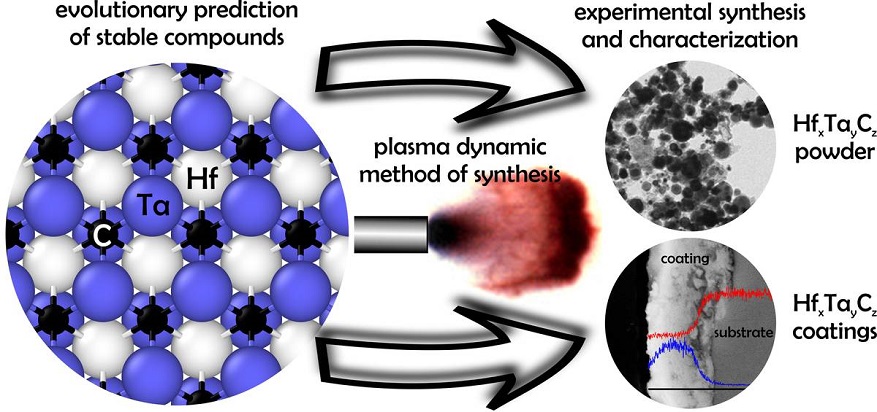Researchers from Skoltech and Tomsk Polytechnic University have applied a unique technology form the aerospace industry to synthesize hafnium-tantalum carbide, a refractory material used for coating electrical and mechanical components that operate under extreme conditions. This inexpensive and efficient method can be used to synthesize high-quality ternary compounds, both as powders and coatings that can be easily applied to various substrates. The research findings are published in Advanced Functional Materials (Q1; IF:18.8).

Image: Visual display of the research: Prediction of stable hafnium-tantalum carbide phases with different proportion of elements and their synthesis as powders and coatings on copper. Credit: Alexander Kvashnin/Skoltech
Transition-metal carbides are considered to be industrially-important materials with ultrahigh melting temperatures, high hardness, and wear resistance. Hafnium and tantalum carbides are the most refractory ones, with the highest melting point close to 4,000 °C. The research, synthesis and application of potential mixed hafnium-tantalum carbides have gained practical interest due to the possibility to increase their melting point. This would allow using the carbides under extreme conditions. In addition, they can potentially be used as catalytic materials for water electrolysis.
Conventional synthesis of refractory transition-metal carbides requires high vacuum and specific sintering techniques, isostatic pressing, and other techniques. Such techniques are expensive and resource-consuming.
Researchers from Skoltech, TPU, and Pirogov University have used an inexpensive and efficient plasma dynamic method to synthesize high-quality ternary Hf-Ta-C compounds, both as powders and coatings that can be easily applied to various substrates.
The technology is based on the generation of high-energy pulsed plasma flows. Similar technologies have been used in aerospace systems since the mid-1960s. Generated hypersonic flows were potentially considered as a source of electromagnetic motion in plasma guns and plasma engines. Various designs of plasma accelerators were proposed to solve the practical problem. By the end of the 20th century, the scope of their application expanded to include the synthesis of functional materials.
The researchers have adapted one of these technologies – the plasma dynamic method – to obtain hafnium-tantalum carbide.
“At first, we pumped a lot of energy into a storage capacitor and used a unique experimental setup designed at TPU – a coaxial magnetic plasma accelerator. We placed source materials, such as powdered carbon, hafnium, and tantalum oxides into the accelerator. Once the capacitors discharge, it triggers an electric arc instantly turning the source materials into a plasma flow with a speed of five kilometers per second. All we need is to collect the end material in form of a powder from the walls of the reactor chamber,” Dmitry Nikitin, co-author of the study, associate professor of the Division for Power and Electrical Engineering, comments.
“We have used up-to-date computational methods together with non-standard experimental techniques for these types of compounds to build a unique research line, aiming to accurately predict the desired properties with further selective and inexpensive synthesis of the novel compounds and functional materials based on them,”
Alexander Kvashnin, lead author of the study, senior lecturer at Skoltech, explains.
The research team predicted 10 phases of hafnium and tantalum carbides, which differ in the relative proportion of the two metals in the obtained material, and synthesized them using the unique experimental setup.
“This method, unlike others, allows us to control the product composition with high selectivity and accuracy,” adds Alexander Kvashnin.
Other methods are powder pressing at pressures 10,000 times higher than normal atmospheric pressure and at high temperatures, and spark plasma sintering under high vacuum. The extreme conditions required to produce hafnium-tantalum carbides are quite difficult to achieve. In addition, both methods require grinding the starting materials into very fine powders to ensure product homogeneity.
The plasma dynamic synthesis method proposed by the research team is not only less demanding of source materials but also it allows depositing hafnium-tantalum carbide coatings on arbitrary surfaces.
“We also deposited some of the 10 compounds, predicted and synthesized in this study, on a copper sample,” adds Alexander Kvashnin.
According to the researchers, such hard coatings could be used for thermal and electrical insulation, as well as for protection from mechanical damages.
“If this piece of copper was a cable, then, by coating it with hafnium-tantalum carbide, we made this cable about 10 times harder as well as heat-shielded and insulated. Other components that operate under extreme conditions could also benefit from such coatings. For example, depositing the coating on bearing balls can considerably enhance their wear resistance,” says Alexander Kvashnin.
“This research is very important as the predicted and synthesized metal carbide nanopowders could also possibly be used in catalytic systems for hydrogen production by water spitting. The collaboration between the TPU Ecoenergy 4.0 Research Center and the Skoltech Project Center for Energy Transition can create impressive new materials for modern energy industry,”
Alexander Pak, head of the Energy of the Future strategic project under the Priority 2030 program, comments on the research results.